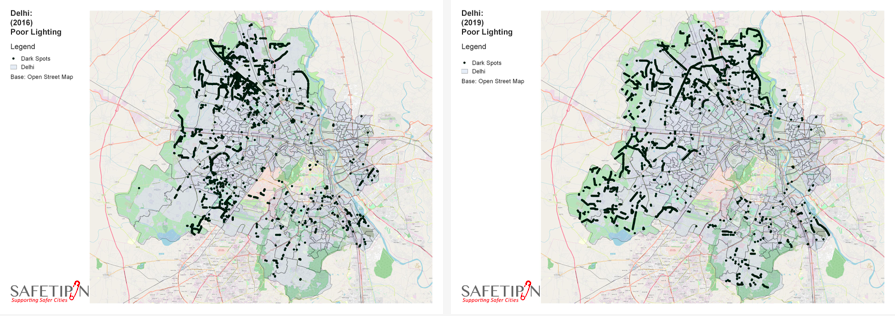Case Study- delhi

Safetipin was launched in Delhi in 2013. We began by crowdsourcing data collection as well as reaching out to students and NGO’s to engage with the app. Within six months, we had collected more than 12,000 audits across different areas of the city. The data was publicised through the media and shared with the city government.
In the second phase of 2015, as part of a three city study with Cities Alliance, we mapped the city using our two apps Safetipin and Safetipin NIte. Over 50,000 points were audited across the city including metro stations and low income neighborhoods. The entire data set was presented to the Delhi government. The government constituted a multi stakeholder group under the aegis of the Power Secretary to respond to our data specifically on dark spots in the city. We had identified 7483 dark spots across the entire city and improvements were done including fixing the existing streetlights and installing additional street lights in the areas of poor lighting.
Further Safetipin also did a safety audit of 15 metro stations around the city for studying the last mile connectivity of the city. Ten important tourist monuments in the city were also mapped on safety parameters.
In 2018, Safetipin was commissioned to conduct a fresh safety mapping of the entire city by the Department of Women and Child Development, Delhi Government. The mapping included streets, as well as transport hubs, markets, public toilets, parks, and other public spaces. Data was collected using two apps – My Safetipin and Safetipin Nite. The former was used to generate data from users and volunteers while the latter generates images of the city which are coded and analyzed for key safety concerns. In total 3,077 kms were covered with 25, 294 audits done throughout the city. The aim of this study in 2018-2019 was to provide concrete evidence of the safety challenges in the city with clear recommendations for improvement. This extensive study also became an example of before and after study for the city due to the availability of preceding data for the city collected in 2015. The data was presented to all the key stakeholders of the city in a meeting chaired by the LG, Anil Baijal. There have been regular meetings to monitor progress on implementation of the recommendations. The Delhi Police are using the data to reformulate the patrolling routes for PCR vans. The data is also used by the Delhi Govt. to put up street lights in the city under the Mukhya Mantri Street light Yojana.

